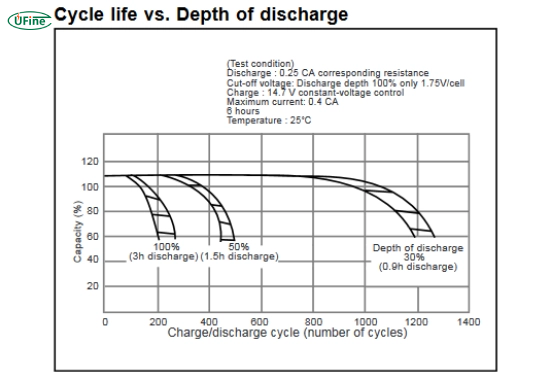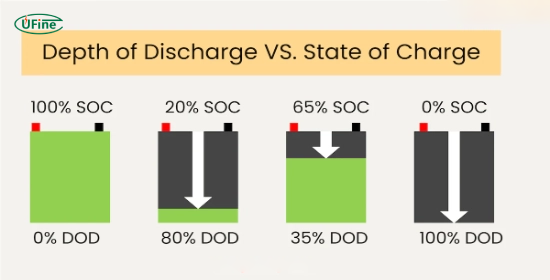Deep discharge refers to discharging a battery significantly, often to the point where it utilizes 80% or more of its capacity. It is crucial to understand how deep-cycle batteries function and how to maintain them for optimal performance. In this article, we will explore the intricacies of deep discharge, its implications for battery life and performance, and the various types of batteries that can handle deep discharges effectively.
Part 1. Understanding depth of discharge (DoD)
Depth of Discharge (DoD) describes the percentage of a battery’s capacity that a user has discharged relative to its total capacity. For instance, if a battery has a total capacity of 100 amp-hours (Ah) and the user has used 80 Ah, the DoD is 80%. This metric is essential because it directly impacts the lifespan and efficiency of rechargeable batteries.
- DoD Calculation: The formula for calculating DoD is straightforward. You can express it as follows:
DoD = (Capacity Used / Total Capacity) × 100%
A higher DoD indicates that more energy has been extracted from the battery. If not appropriately managed, this can lead to faster degradation.
Batteries frequently subjected to high DoD levels may not last as long as those kept within safer discharge limits. For example, you consistently use 80% of your battery’s capacity before recharging.
In that case, you may find that its overall lifespan decreases compared to a battery that discharges only 50% before being recharged.
Part 2. What happens during deep discharge?
When a battery undergoes deep discharge, several critical changes occur:
- Voltage Drop: As the battery discharges, its voltage decreases. Each battery type has a specific cut-off voltage where it ceases to function effectively. For example, lead-acid batteries typically should be discharged at 10.5 volts.
- Increased Internal Resistance: Deep discharging can increase the battery’s internal resistance. This makes it more challenging to recharge effectively and can lead to overheating during charging.
- Potential Damage: If discharged too profoundly, particularly in non-deep-cycle batteries, irreversible damage can occur. This may include sulfation in lead-acid batteries or lithium plating in lithium-ion batteries. Sulfation occurs when lead sulfate crystals form on the battery plates during discharge and do not dissolve into the electrolyte during charging.
Part 3. Types of batteries that can handle deep discharge
Not all batteries function well in deep discharge applications. Here are the primary types that can manage this process effectively:
- Deep-cycle batteries: These batteries are designed to be regularly discharged to significant depths. They are commonly used in solar energy systems, electric vehicles, and marine applications.
- Lithium-ion Batteries: Due to their advanced chemistry and design, lithium-ion batteries can handle deep discharges better than traditional lead-acid batteries. They also have a higher energy density, meaning they can store more energy in a smaller space.
- Absorbent Glass Mat (AGM) Batteries: A subtype of lead-acid batteries that can tolerate deep discharges requiring less maintenance. AGM batteries are sealed and do not require water replenishment like traditional flooded lead-acid batteries.
Part 4. What is the difference between depth of discharge and state of charge?
Understanding the Depth of Discharge (DoD) and State of Charge (SoC) is essential for effective battery management.
- Depth of Discharge (DoD) measures the energy a battery has used. For example, if you have a fully charged battery rated at 100 Ah and used 40 Ah, your DoD is 40%.
- The state of Charge (SoC) indicates how much energy remains available in the battery at any given time. Using the previous example, if you have used 40 Ah from your fully charged 100 Ah battery, your SoC would be 60%.
In summary:
- DoD focuses on how much energy has been consumed.
- SoC focuses on how much energy is left.
Both metrics are crucial for maintaining battery health and ensuring efficient usage.
Battery State of Charge and Battery State of Health
Part 5. Benefits of deep discharge capabilities
Batteries designed for deep discharge offer several advantages:
- Extended Usage Time: They provide sustained power over longer periods, making them ideal for off-grid applications with limited recharging options.
- Cost Efficiency: While they may have a higher upfront cost, their ability to cycle deeply means they can be more economical over time due to reduced replacement frequency.
- Versatility: You can use deep-cycle batteries in various applications, from recreational vehicles (RVs) to renewable energy systems.
Part 6. The Importance of battery management systems
To maximize the lifespan and performance of batteries subjected to deep discharge cycles, implementing a Battery Management System (BMS) is crucial. A BMS helps monitor:
- State of Charge (SoC): This indicates how much charge remains in the battery.
- Temperature Control: Overheating during charging or discharging can damage the battery.
- Discharge Limits: Preventing deep discharges beyond recommended levels protects the battery from potential damage.
A BMS allows users to track their battery’s health and performance quickly. It alerts us when it’s time to recharge or if any issues need addressing.
Part 7. How to protect against deep discharge?
To safeguard your batteries from the adverse effects of deep discharge:
- Set Discharge Limits: Use devices or systems that automatically cut off power when a specific DoD is reached. This prevents over-discharging, which can cause damage.
- Regular Maintenance: For flooded lead-acid batteries, ensure proper water levels and clean terminals regularly to maintain good conductivity.
- Monitor Performance: Monitor voltage levels during use and recharge promptly when necessary. Voltmeters or smart chargers can help you track this information efficiently.
Part 8. Common applications for deep discharge batteries
Deep discharge batteries are widely used across various sectors:
- Renewable Energy Systems: Solar energy storage requires batteries that can handle frequent deep discharges without significant degradation over time.
- Electric Vehicles (EVs): EVs rely on deep-cycle capabilities for extended driving ranges between charges, allowing drivers to travel longer distances without needing frequent recharges.
- Marine Applications: Boats often utilize deep-cycle batteries because they can withstand repeated discharges and provide reliable power for onboard systems like lights and navigation equipment.
Part 9. FAQs
-
What is considered a deep discharge?
A deep discharge typically means discharging a battery by 80% or more of its total capacity. -
Can all batteries handle deep discharge?
Only specific types, like deep-cycle and lithium-ion batteries, are designed for frequent deep discharges without sustaining damage. -
How does deep discharge affect battery lifespan?
Frequent deep discharges can significantly reduce a battery’s lifespan by increasing wear and tear on its internal components due to chemical reactions within the battery cells. -
What precautions should I take when using deep-cycle batteries?
Ensure you monitor your usage closely, set proper discharge limits using a BMS, and perform regular maintenance checks on your battery system. -
Are there any signs that my battery has been damaged from deep discharge?
Yes, signs include reduced capacity (the battery also doesn’t hold charge), increased heat during charging cycles, or physical swelling, especially with lithium-ion batteries.
Related Tags:
More Articles

How to Choose the Best Floor Scrubber Battery for Commercial Cleaning?
Selecting the ideal floor scrubber battery ensures a long runtime, rapid charging, and minimal maintenance for efficient commercial cleaning operations.
Battery for Blower vs Battery for Leaf Vacuum: Which One Should You Choose?
Battery for blower vs leaf vacuum—learn the key differences in power, fit, and runtime to choose the right battery for your outdoor tool needs.
How to Choose the Right Battery for Blower?
Choosing the right blower battery? Consider voltage, capacity, chemistry & usage. This guide helps match the best battery for peak performance.
How to Choose the Best Insulated Battery Box for Lithium Batteries?
Choosing the Best Insulated Battery Box for Lithium Batteries? Discover key factors such as size, material, and safety for optimal protection and performance.
7 Critical Elements on a Lithium Battery Shipping Label
What must be on a lithium battery shipping label? Learn 7 key elements to ensure safety, legal compliance, and correct handling across all transport modes.





